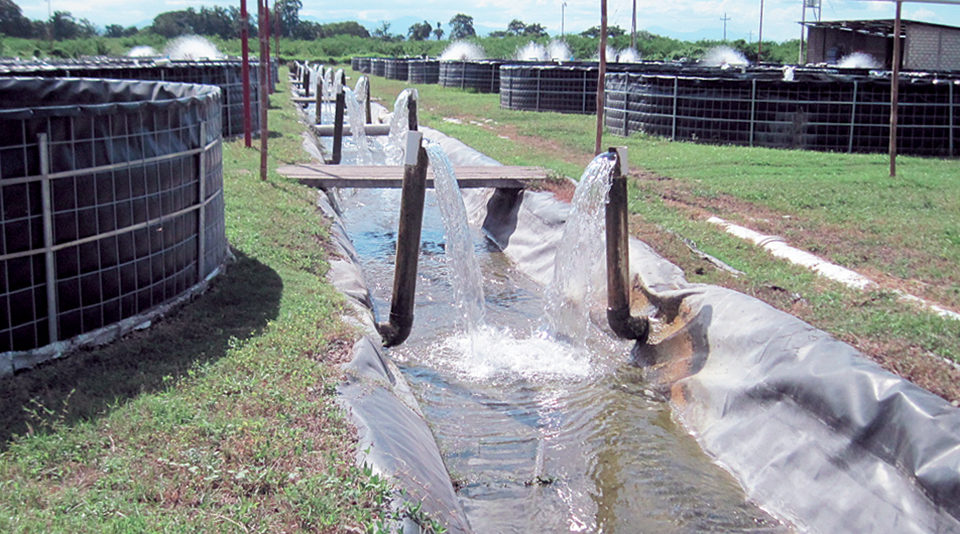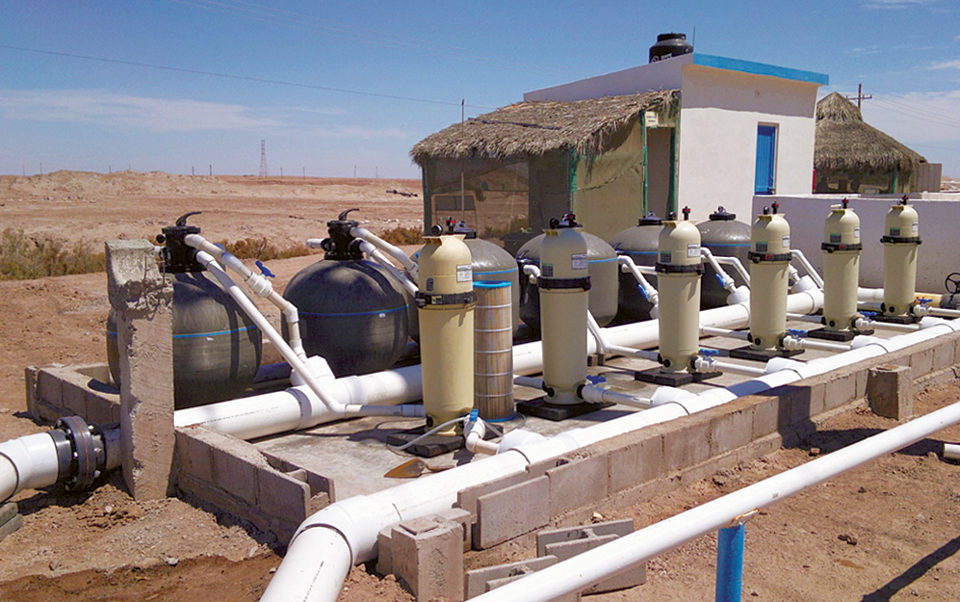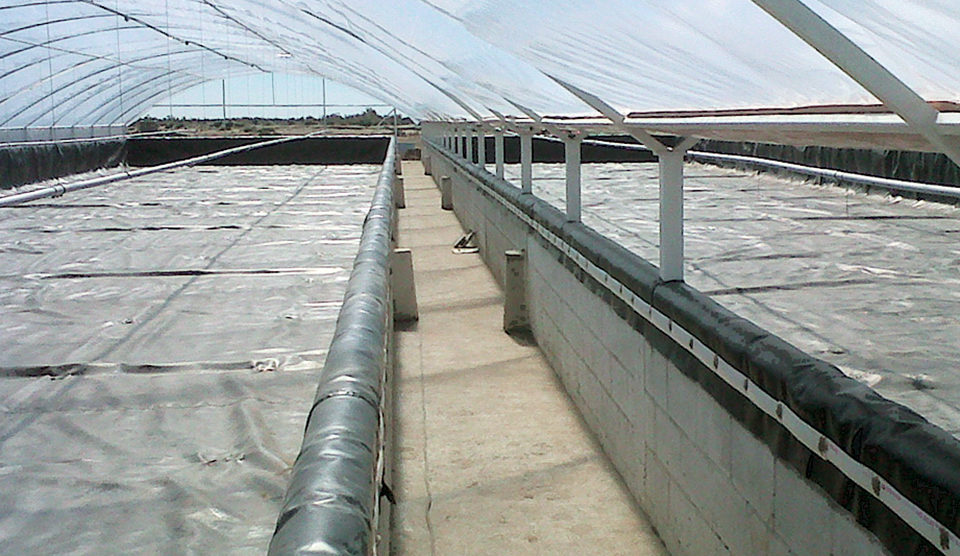Concept has evolved to control animal health, water quality conditions

Shrimp raceway technology has been refined over the last eight years to improve production system efficiency. In parallel, producer interest has increased, as raceway systems can mitigate the adverse effects of poor weather and diseases.
In the early days, the raceway concept started with the objective of acclimatizing animals to growout system conditions. The concept has since evolved to control animal health and water quality conditions, to optimize and improve feeding efficiency, to improve survival during the first days of culture and to prevent exposure of the animals to disease vectors that can result in early outbreaks in ponds.
Raceway requirements
Shrimp are transferred from hatcheries at postlarval stages of P.L.6 to P.L.12, depending on farm salinity, and instead of being directly stocked into ponds, they are stocked in different-shaped tanks at farms at higher densities than in growout ponds. The raceways typically operate with zero water exchange.
The higher stocking densities and zero water exchange demand higher technology, more infrastructure, increased biosecurity, and additional controls and tools. Raceways require filtration systems, efficient aeration systems, good water quality, the use of microorganisms, siphoning, temperature control, greenhouse structures and better feeds – all with the objective of keeping a stable environment for strong, healthy animals.
Another benefit of these systems takes advantage of the compensatory growth that occurs when Litopenaeus vannamei are finally stocked in growout ponds. Compensatory growth reduces cycle length and improves feed conversion.

Key factors
Once adequate raceway infrastructure is in place, a very important factor learned from experience in the different countries where the technology has been used is that the staff in charge of the raceways should have a hatchery background in order to maintain the required level of control.
The application of probiotics, microorganisms that have health benefits when consumed, is a key component in these systems. The protocols for the different probiotics must be adjusted depending on the biomass, water quality conditions and animal conditions.
To deal with organics, for example, 1 to 3 ppm of probiotic should be added every 72 hours. To deal with toxics, 2 to 5 ppm of probiotic should be added every 48 hours. For pathogens in water, 5 to 10 ppm of probiotic should be added until the pathogens are controlled. To deal with pathogens in the gut, 1-4 g probiotic/kg of feed should be added.
The feeds used in these systems have to be of hatchery quality. Trying to use growout-quality feeds impacts water quality and subsequently results in bacteriological problems that can lead to poor production performance and weak animals.
The last key component is having the tools and expertise to properly transfer the animals from the raceways to the ponds. Animals must be healthy and strong before transfer. Otherwise, all that was gained in the previous stage can be lost.
A lot of technology has been developed in this area. At the beginning, transfers were made with wet animals for short distances. Today, transfers are made to ponds up to 2 km away from the raceway units using specially designed pumps that minimize animal stress and mortalities.
The trend today is to lower densities in order to achieve higher weights in raceways. Biomasses of up to 7 kg/m3 have been achieved. Average results for weight and survival at different stocking densities and culture periods are summarized in Table 1.
Garcia, Average results for shrimp raised in raceways, Table 1
| Density (shrimp/L) | Days | Survival (%) | Average Weight (g) |
|---|
Density (shrimp/L) | Days | Survival (%) | Average Weight (g) |
|---|---|---|---|
| 1.8 | 57 | 86 | 4.00 |
| 1.8 | 45 | 89 | 2.00 |
| 2.0 | 35 | 87 | 1.00 |
| 4.0 | 35 | 85 | 0.80 |
| 8.0 | 35 | 80 | 0.48 |
| 12.0 | 35 | 78 | 0.30 |
| 22.0 | 35 | 74 | 0.25 |
Raceways in Mexico
The impacts of early mortality syndrome/acute hepatopancreatic necrosis (EMS/AHPN) in Mexico have been severe. Production dropped approximately 50 percent in 2013. Based on previous experience with white spot syndrome (WSS), most farms tried to achieve large-size animals after the EMS outbreak, as they used to do after WSS affected farms. However, with EMS disease, pond populations continue to decrease and reduce final survival rates.
According to information supplied by Proaqua Mexico, a leading supplier of specialized aquaculture equipment and feeds, no EMS outbreaks have been reported in raceways, regardless of the time spent in the raceways. However, mortalities develop once animals are stocked in ponds.
With this experience and taking advantage of the large raceway infrastructure in Mexico, a few groups changed the production strategy for the second cycle. They lowered stocking densities, extended the days of culture in the raceways and then shortened growout cycles in the ponds to target smaller shrimp and more growout cycles.
Some of these farms stocked raceways at an average of 1.5 shrimp/L for 55 days, achieving 4.5-g weight and 80 percent survival. When stocked in growout ponds at an average of 6.5 animals/m2, the shrimp reached 16 to 18 g in 30 days of culture. The harvested animals reflected an average feed-conversion ratio (FCR) of 0.6 and average survival of 85 percent.
The farms managed to run four cycles in growout ponds with this approach. They produced over 3,000 kg/ha during 2013 with fewer days of culture and lower FCR.

Implementation elsewhere
Several attempts to transfer this concept to countries in Southeast Asia have yielded mixed results. Farmers have tried building raceways at farms, but with insufficient biosecurity, tools and technology, they encountered problems with size variation, survival and transfers.
Alternative ideas were put in place. Stocking in cages within ponds with no soil contact for the first 30 days reportedly avoided EMS outbreaks. Also, segregating young animals within a 20 to 30 percent section of ponds with nets and then releasing the shrimp to the remaining pond areas after 20 to 30 days has been reported to help.
A successful experience with the implementation of raceways has been reported in Malaysia with good production performance, successful transfer of the animals to growout ponds and successful harvest in a shorter pond cycle. There is still room to improve by adjusting feeding regimes, probiotic protocols and temperature conditions in order to achieved better weights in the raceways.
(Editor’s Note: This article was originally published in the March/April 2014 print edition of the Global Aquaculture Advocate.)
Authors
-
Fernando Garcia
Epicore BioNetworks Inc.
4 Lina Lane
Eastampton, New Jersey 08060 USA -
Fabrizzio Vanoni
Epicore BioNetworks Inc.
4 Lina Lane
Eastampton, New Jersey 08060 USA -
William Long
Epicore BioNetworks Inc.
4 Lina Lane
Eastampton, New Jersey 08060 USA -
Dirk Lorenz-Meyer
Epicore BioNetworks Inc.
4 Lina Lane
Eastampton, New Jersey 08060 USA
Tagged With
Related Posts

Intelligence
A land grab for salmon (and shrimp) in upstate New York
The operators of Hudson Valley Fish Farm see their inland locale as a pilot to prove that land-based fish farming, located in close proximity to major metropolitan markets, can be successful.

Responsibility
A look at various intensive shrimp farming systems in Asia
The impact of diseases led some Asian shrimp farming countries to develop biofloc and recirculation aquaculture system (RAS) production technologies. Treating incoming water for culture operations and wastewater treatment are biosecurity measures for disease prevention and control.

Health & Welfare
A holistic management approach to EMS
Early Mortality Syndrome has devastated farmed shrimp in Asia and Latin America. With better understanding of the pathogen and the development and improvement of novel strategies, shrimp farmers are now able to better manage the disease.

Responsibility
Addressing safety in Latin America’s tilapia supply chain
Over the last decade, the experience gained by many tilapia farmers combined with proficient programs implemented by local governments have significantly improved tilapia production in various Latin American countries like Colombia, Mexico, Ecuador and other important tilapia producers in the region.


